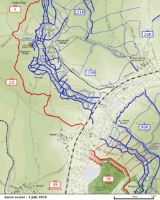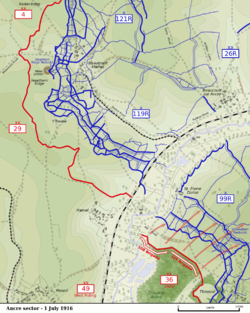
Hawthorn Ridge Redoubt
Encyclopedia

Germany
Germany , officially the Federal Republic of Germany , is a federal parliamentary republic in Europe. The country consists of 16 states while the capital and largest city is Berlin. Germany covers an area of 357,021 km2 and has a largely temperate seasonal climate...
front-line fortification west of the village of Beaumont Hamel on the Somme
Somme River
The Somme is a river in Picardy, northern France. The name Somme comes from a Celtic word meaning tranquility. The department Somme was named after this river....
. It was the scene of a number of costly attacks by British
United Kingdom
The United Kingdom of Great Britain and Northern IrelandIn the United Kingdom and Dependencies, other languages have been officially recognised as legitimate autochthonous languages under the European Charter for Regional or Minority Languages...
infantry
Infantry
Infantrymen are soldiers who are specifically trained for the role of fighting on foot to engage the enemy face to face and have historically borne the brunt of the casualties of combat in wars. As the oldest branch of combat arms, they are the backbone of armies...
during the Battle of the Somme in 1916. It was also the site of one of the most famous pieces of film footage of World War I
World War I
World War I , which was predominantly called the World War or the Great War from its occurrence until 1939, and the First World War or World War I thereafter, was a major war centred in Europe that began on 28 July 1914 and lasted until 11 November 1918...
when the Hawthorn Ridge mine was detonated beneath the redoubt
Redoubt
A redoubt is a fort or fort system usually consisting of an enclosed defensive emplacement outside a larger fort, usually relying on earthworks, though others are constructed of stone or brick. It is meant to protect soldiers outside the main defensive line and can be a permanent structure or a...
at 7:20 am on 1 July 1916, the first day on the Somme
First day on the Somme
The first day on the Somme, 1 July 1916, was the opening day of the Battle of Albert, which was the first phase of the British and French offensive that became known as the Battle of the Somme...
.

Royal Engineer tunnelling companies
Royal Engineer tunnelling companies were specialist units of the Corps of Royal Engineers within the British Army, formed to dig attacking tunnels under enemy lines during the First World War....
. It was detonated on July 1, one of the three large mines, the other two being the Lochnagar mine
Lochnagar mine
The Lochnagar mine was an explosive-packed mine created by the Royal Engineer tunnelling companies, located south of the village of La Boisselle in the Somme département of France, which was detonated at 7:28 am on 1 July 1916, the first day of the Battle of the Somme...
and the Y Sap mine at La Boisselle. The mine contained about 40000 pound of explosives. The plan was to detonate all other mines at 7:28 am, two minutes before Zero hour when the infantry advance would begin, but Lieutenant-General Aylmer Hunter-Weston
Aylmer Hunter-Weston
Lieutenant-General Sir Aylmer Gould Hunter-Weston KCB DSO GStJ was a British Army general who served in World War I at Gallipoli and the Somme Offensive...
, whose VIII Corps was holding the Hawthorn Ridge sector, favoured blowing the mine hours before the main attack, believing this would give his 29th Division time to capture and consolidate the crater
Subsidence crater
A subsidence crater is a hole or depression left on the surface of an area which has had an underground explosion. Many such craters are present at the Nevada Test Site, which is no longer in use for nuclear testing....
. However, the Fourth Army commander, Lieutenant-General Henry Rawlinson rejected this proposal on the grounds that the Germans would probably take possession of the crater. In this stance he was supported by General Sir Douglas Haig
Douglas Haig, 1st Earl Haig
Field Marshal Douglas Haig, 1st Earl Haig, KT, GCB, OM, GCVO, KCIE, ADC, was a British senior officer during World War I. He commanded the British Expeditionary Force from 1915 to the end of the War...
, commander of the British Expeditionary Force. As a compromise, Hunter-Weston was allowed to blow the mine ten minutes before Zero, rather than two minutes.
One witness to the detonation of the Hawthorn Ridge mine was British cinematographer
Cinematographer
A cinematographer is one photographing with a motion picture camera . The title is generally equivalent to director of photography , used to designate a chief over the camera and lighting crews working on a film, responsible for achieving artistic and technical decisions related to the image...
Geoffrey Malins who was filming the 29th Division's attack. He had his camera set up about half a mile away, trained on the ridge and waiting for the explosion.

Platoon
A platoon is a military unit typically composed of two to four sections or squads and containing 16 to 50 soldiers. Platoons are organized into a company, which typically consists of three, four or five platoons. A platoon is typically the smallest military unit led by a commissioned officer—the...
s of the 2nd Battalion, Royal Fusiliers (86th Brigade, 29th Division) were sent forward to occupy the crater. However, the German defenders succeeded in holding the eastern lip of the crater. The early detonation alerted all Germans in the vicinity that the long-expected attack was now imminent. By the time the infantry went over at 7:30 am, the German machine gun
Machine gun
A machine gun is a fully automatic mounted or portable firearm, usually designed to fire rounds in quick succession from an ammunition belt or large-capacity magazine, typically at a rate of several hundred rounds per minute....
s were sweeping no man's land
No man's land
No man's land is a term for land that is unoccupied or is under dispute between parties that leave it unoccupied due to fear or uncertainty. The term was originally used to define a contested territory or a dumping ground for refuse between fiefdoms...
and artillery
Artillery
Originally applied to any group of infantry primarily armed with projectile weapons, artillery has over time become limited in meaning to refer only to those engines of war that operate by projection of munitions far beyond the range of effect of personal weapons...
fire was falling on the British trenches. The attack on Hawthorn Ridge redoubt, and on the entire VIII Corps front, ended in failure. By 8:30 am, the only "gain" by the 29th Division was one company clinging to the western lip of the crater but by the end of the day this too was lost.
After the disaster of the first day on the Somme, British efforts were concentrated south of the Albert-Bapaume
Bapaume
Bapaume is a commune and the seat of a canton in the Pas-de-Calais department in the Nord-Pas-de-Calais region of France.-Geography:A farming and light industrial town located 10 miles south of Arras at the junction of the A1 autoroute and the N17 and N30 national roads its location is...
road and the Hawthorn Ridge sector was not subjected to further major attacks until the final push of the battle on 13 November with the opening of the Battle of the Ancre
Battle of the Ancre
The Battle of the Ancre was the final act of the 1916 Battle of the Somme. Launched on 13 November 1916 by the British Fifth Army of Lieutenant General Hubert Gough, the objective of the battle was as much political as military.-Prelude:The Allied commanders were due to meet at Chantilly on 15...
. For this attack another mine was laid beneath Hawthorn Ridge, this time containing 30,000 lb (13 tons) of explosives. On this occasion, superior British planning resulted in a successful assault and Hawthorn Ridge as well as Beaumont Hamel were finally captured.

